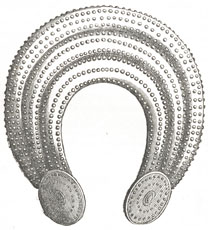Gold Ornaments
The collection of antiquities in the Royal Irish Academy, furnishes abundant evidence that the pagan Irish were well skilled in the higher arts of working in metals. If the arbitrary division of the ages of stone, bronze, and iron, can be made to hold good, we must either suppose that the Irish Celt was possessed of extraordinary mental powers, by which he developed the mechanical arts gradually, or that, with successive immigrations, he obtained an increase of knowledge from exterior sources. The bardic annals indicate the latter theory. We have already given several illustrations of the ruder weapons.

Gold Head-Dress, R.I.A.
The illustration appended here may give some idea of the skill obtained by our pagan ancestors in working gold. This ornament, which is quite complete, though fractured in two places, stands 11 ½ inches high. It weighs 16 oz. 10 dwts. 13 grs. The gold of which it is formed is very red. It was procured with the Sirr Collection, and is said to have been found in the county Clare.[5] Our readers are indebted to the kindness of the Council of the Royal Irish Academy, for the permission to depict these and the other rare articles from the collection which are inserted in our pages.
The amount of gold ornaments which have been found in Ireland at various times, has occasioned much conjecture as to whether the material was found in Ireland or imported. It is probable that auriferous veins existed, which were worked out, or that some may even now exist which are at present unknown. The discovery of gold ornaments is one of the many remarkable confirmations of the glowing accounts given by our bardic annalists of Erinn's ancient glories. O'Hartigan thus describes the wealth and splendour of the plate possessed by the ancient monarchs who held court at Tara:—
"Three hundred cupbearers distributed
Three times fifty choice goblets
Before each party of great numbers,
Which were of pure strong carbuncle,[6]
Or gold or of silver all."
Dr. Petrie observes that this statement is amply verified by the magnificent gold ornaments, found within a few yards of this very spot, now in the possession of the Royal Irish Academy. We shall see, at a later period, when the cursing of Tara will demand a special notice of its ancient glories, how amply the same writer has vindicated the veracity of Celtic annalists on this ground also.
Notes
[5] Clare.—In 1855, in digging for a railway-cutting in the county Clare, gold ornaments were found worth £2,000 as bullion.
[6] Carbuncle.—This word was used to denote any shining stone of a red colour, such as garnet, a production of the country.
